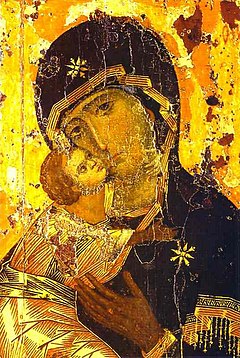  |
 Forget your perfect offering There is a crack, a crack in everything That's how the light gets in." Leonard Cohen, Anthem 
    "[T]he shattering of the mind of samsara [...] is not necessarily bound up with zazen meditation.”[3]            |
| “ | The amount of energy necessary to refute bullshit is an order of magnitude bigger than to produce it. |
” |
| — Alberto Brandolini[9] | ||
| “ | Nothing is lacking,[10] nothing is hidden[11] | ” |
| — Linji (paraphrased), Barry Magrid | ||
| “ | Emptiness is the unborn and undying Buddha-mind.[12] | ” |
| “ | Question: Isn't [It] just empty space? Answer: Originally it is not empty. It is always bright and never obscured. |
” |
| — Chinul[13] | ||
| “ | Noem het liefde, noem het leegte | ” |
| — Rumi[14] | ||
| “ | Self-restraint[note 8] and benefiting others With a compassionate mind is the Dharma |
” |
| — Nagarjuna[note 9] | ||
| “ | The main thing is to develop a good heart | ” |
| — Gen Lamrimpa[note 10] | ||
| “ | Merit consists in doing good to others, sin in doing harm to others. | ” |
| — Tukaram | ||
| “ | A good man is a wise man | ” |
| — Krishnamurti[note 12] | ||
| “ | Knowledge speaks, wisdom listens | ” |
| — Jimi Hendrix[note 13] | ||
| “ | Being less reactive and more wisely responsive in any situation, you become a light in the world, contributing to less suffering and more happiness and well being for others and yourself. |
” |
| — Richard Shankman[19] | ||
| “ | Don’t be cruel. Elvis said it, and it’s true. | ” |
| — Garrison Keillor[20] | ||
| “ | God is love, and he who abides in love abides in God and God in him. | ” |
| — 1 John 4:16 | ||
| “ | having nothing—nothing—to do with fame or profit in any shape or form | ” |
| — Hakuin[21][note 14][21] | ||
| “ | Compassion is the crown of dharma. | ” |
| — Nícaldās, The Ocean of Inquiry[22] | ||
| “ | Neem het leven niet te serieus, je overleeft het toch niet. | ” |
| — Armand | ||
| “ | Do not take life too seriously. You will never get out of it alive. | ” |
| — Elbert Hubbard | ||
| “ | I think that the gist is that the Wikipedian is essentially unfree. Here we are not free to write what we please. Those who thrive upon Wikipedia have long understood that they are not here to serve themselves or their own ideological/religious preferences [...] I don't see my role as a Wikipedian as promoting my own personal preferences. I am not here to proselytize or evangelize. I serve the propagation of academic learning, since this is the main purpose of Wikipedia. | ” |
| — Tgeorgescu[23] | ||
- ^ a b The Existential Buddhist, On Hakuin, Hotei, and Mice
- ^ livingworkshop.net, Budai
- ^ Jeff Shore, What is a koan? And what do you do with it?, p.14, quoting Mujaku Dōchū
- ^ Reverend Eshin, Ten Oxherding Pictures
- ^ Gómez (1983), The direct and gradual approaches of Zen master Mahayana, pp 108–109; in Gimello and Gregory 1983 (eds) (1983), Studies in Ch’an and Hua-yen, University of Hawai‘i Press, pp 69–167; cited in Paul Williams (1994), Mahayana Buddhism, p.195-196
- ^ Patrick Jennings, Tsongkhapa: In Praise of Relativity; The Essence of Eloquence
- ^ Maha Karuna Chan (Ton Lathouwers), Sutra van Quanyin
- ^ Rabindranath Tagore, "Bharat Tirtha"
- ^ Stephen Knight, The European Scientific Journal Did Not Conclude 9/11 Was A ‘Controlled Demolition’
- ^ Promo-text for "The Record Of Linji: A New Translation Of The Linjilu In The Light Of Ten Japanese Zen Commentaries," by Jeffrey L. Broughton with Elise Yoko Watanabe, 臨濟義玄 Linji Yixuan (?–866), terebess
- ^ Barry Magrid
- ^ Vrij naar Bankei en Hakuin; Hakuin, Idel Talk on a Night Boat (2009), p.94
- ^ Buswell, Jr. (1983), The Korean Approach to Zen: The Collected Works of Chinul, p.146
- ^ Felicia Dekkers (2024), De leegte als bron, nieuwwij.nl
- ^ Vetter, Tilmann (1988), The Ideas and Meditative Practices of Early Buddhism, BRILL
- ^ Williams (2000), Buddhist Thought, p.46
- ^ Frauwallner, E. (1973), History of Indian Philosophy, trans. V.M. Bedekar, Delhi: Motilal Banarsidass. Two volumes., pp.150 ff
- ^ Krishnamurti and Needleman, Conversations with Jacob Needleman
- ^ Richard Shankman
- ^ Garrison Keillor, Trump voters will not like what happens next, The Washington Post November 9 2016
- ^ a b Hakuin, Wild Ivy, tr. Norman Waddell; see Post-satori practice and Hakuin#Final awakening
- ^ Micahel S. Allen (2017), Greater Advaita Vedanta: The Case of Nícaldās. International Journal of Hindu Studies (2017), 21
- ^ diff
Cite error: There are <ref group=note> tags on this page, but the references will not show without a {{reflist|group=note}} template (see the help page).